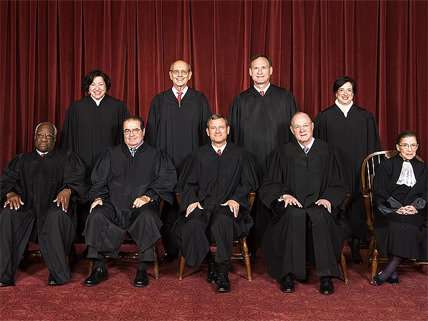Supreme Court Agrees to Hear New Abortion Case
Abortion is headed back to SCOTUS.

The legal controversy surrounding abortion is headed back to the U.S. Supreme Court. On Friday afternoon the justices agreed to review the constitutionality of a Texas law which threatens to close all but a handful of the state's abortion clinics in the name of public health.
At issue in Whole Woman's Health v. Cole are two provisions from a 2013 Texas statute known as H.B. 2. The first of those challenged provisions requires all abortion clinics to upgrade their facilities in order to meet the same standards required of ambulatory surgical centers. The second challenged provision requires all physicians performing abortions to have admitting privileges at nearby hospitals. If allowed to go into effect, these regulations would shutter more than 75 percent of the state's abortion clinics.
Texas justifies its regulations as legitimate exercises of the state's police power to protect public health and safety. Whole Woman's Health argues that the state's regulations do not protect health and safety and are in fact mere pretexts designed to harass and eliminate the state's abortion providers.
In most cases dealing with ostensible public health and safety regulations, the Supreme Court employs a legal approach known as the rational-basis test. As the Court once described it, under the rational-basis test, "the burden is on the one attacking the legislative arrangement to negative every conceivable basis which might conceivably support it." Put differently, the legal challengers must not only defeat the government's stated rationale for the regulation in question, they must also defeat any hypothetical rationale that the government, or even the presiding judge, might "conceivably" think up before or during trial. Needless to say, this highly deferential approach tips the scales strongly in favor of government regulation.
But abortion regulations are treated somewhat differently. In the abortion context, the Court's legal approach is also informed by something known as the "undue burden" test. This test originated in the Court's 1992 decision in Planned Parenthood of Southeast Pennsylvania v. Casey, in which the Court upheld most of the challenged provisions from a Pennsylvania abortion statute, yet struck down one provision for placing an undue burden on a woman's right to abortion under the Due Process Clause of the 14th Amendment.
What exactly counts as an undue burden? Here's how the Court explained it in Casey. "A finding of an undue burden is a shorthand for the conclusion that a state regulation has the purpose or effect of placing a substantial obstacle in the path of a woman seeking an abortion of a nonviable fetus." As the Court noted, "unnecessary health regulations that have the purpose or effect of presenting a substantial obstacle to a woman seeking an abortion impose an undue burden on the right."
Is Texas law H.B. 2 an unnecessary regulation that places a substantial obstacle in the path of women seeking to exercise their constitutional rights, or is it instead a necessary regulation that advances public health and can therefore survive scrutiny under the undue burden test?
Those questions will be at the center of the Supreme Court's analysis in Whole Woman's Health v. Cole. Oral arguments in the case are likely to occur sometime in spring 2016.


Show Comments (67)